Themed collection Ultrafast photoinduced energy and charge transfer

List of participants
Poster list
Correction: Role of charge transfer states into the formation of cyclobutane pyrimidine dimers in DNA
Ultrafast photoinduced energy and charge transfer: concluding remarks
This article summarizes the papers presented and discussed at the 2019 Faraday discussion meeting on Ultrafast Photoinduced Charge and Energy Transfer. It also reflects on the remarkable progress in time-resolved studies since a related and pioneering discussion meeting that took place in 1959.
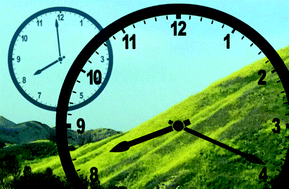
Faraday Discuss., 2019,216, 564-573
https://doi.org/10.1039/C9FD90030F
Quantum interferences among Dexter energy transfer pathways
We explore Dexter coupling pathway interferences in non-covalent assemblies, employing a method that enables the assessment of Dexter coupling pathway strengths, interferences, and their physical origins in the context of one-particle and two-particle (i.e., coulombic) operators.
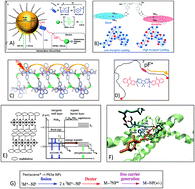
Faraday Discuss., 2019,216, 301-318
https://doi.org/10.1039/C9FD00007K
Two-dimensional electronic vibrational spectroscopy and ultrafast excitonic and vibronic photosynthetic energy transfer
2-Dimensional electronic vibrational spectroscopy presents a novel experimental and theoretical approach to study energy transfer.
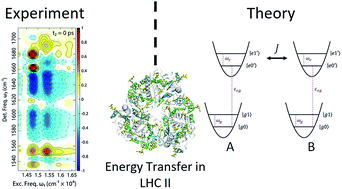
Faraday Discuss., 2019,216, 116-132
https://doi.org/10.1039/C8FD00190A
Ultrafast photoinduced energy and charge transfer
After presenting the basic theoretical models of excitation energy transfer and charge transfer, I describe some of the novel experimental methods used to probe them. Finally, I discuss recent results concerning ultrafast energy and charge transfer in biological systems, in chemical systems and in photovoltaics based on sensitized transition metal oxides.
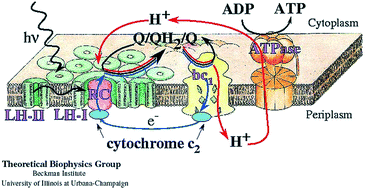
Faraday Discuss., 2019,216, 9-37
https://doi.org/10.1039/C9FD00036D
Turning the challenge of quantum biology on its head: biological control of quantum optical systems
Strong coupling between plasmon modes and chlorins in synthetic light-harvesting maquette proteins yields hybrid light-matter states (plexcitons) whose energies are controlled by design of protein structure, enabling the creation of new states not seen under weak coupling.

Faraday Discuss., 2019,216, 57-71
https://doi.org/10.1039/C8FD00241J
Band-selective dynamics in charge-transfer excited iron carbene complexes
A combination of ultrafast spectroscopy and DFT/TD-DFT calculations of a recently synthesised iron carbene complex elucidates the ultrafast excited state evolution processes in these systems.
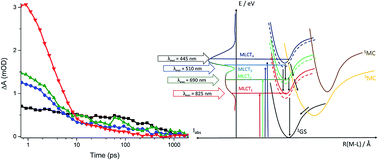
Faraday Discuss., 2019,216, 191-210
https://doi.org/10.1039/C8FD00232K
Measuring local conformations and conformational disorder of (Cy3)2 dimer labeled DNA fork junctions using absorbance, circular dichroism and two-dimensional fluorescence spectroscopy
In this work, we use absorbance, circular dichroism (CD), and two-dimensional fluorescence spectroscopy (2DFS) to study the local conformations and conformational disorder within chromophore-labeled DNA constructs.
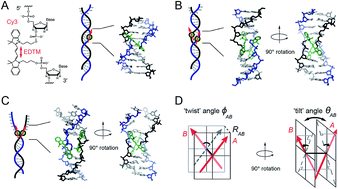
Faraday Discuss., 2019,216, 211-235
https://doi.org/10.1039/C8FD00245B
A theoretical study on the dynamics of light harvesting in the dimeric photosystem II core complex: regulation and robustness of energy transfer pathways
Coarse-grained model for dimeric PSII core complex reveals robust light harvesting through inter-monomer energy transfer and pooling in CP47s.
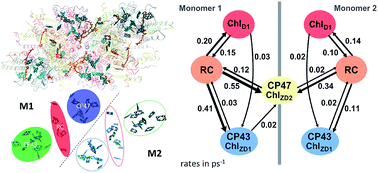
Faraday Discuss., 2019,216, 94-115
https://doi.org/10.1039/C8FD00205C
How charges separate: correlating disorder, free energy, and open-circuit voltage in organic photovoltaics
In this paper, we discuss our recent efforts to correlate the role of density of states, entropy, and configurational and energetic disorder to the open-circuit voltage, VOC, of model type-II organic polymer photovoltaics.
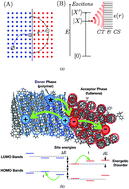
Faraday Discuss., 2019,216, 236-251
https://doi.org/10.1039/C8FD00182K
Can we use on-the-fly quantum simulations to connect molecular structure and sunscreen action?
Direct MCTDH quantum dynamics simulations, with automatic active coordinate generation, applied to potential molecular sunscreens.
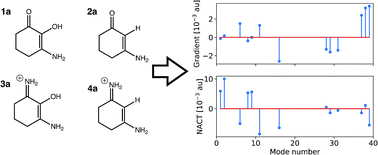
Faraday Discuss., 2019,216, 476-493
https://doi.org/10.1039/C8FD00228B
Transient synchronisation and quantum coherence in a bio-inspired vibronic dimer
We consider energy transfer in a vibronic dimer and show that the synchronisation dynamics of local mode displacements exhibit a rich behaviour which arises directly from the distinct time-evolutions of different vibronic quantum coherences.
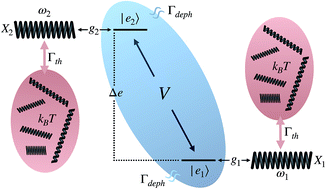
Faraday Discuss., 2019,216, 38-56
https://doi.org/10.1039/C9FD00006B
Two-photon excitation spectroscopy of photosynthetic light-harvesting complexes and pigments
Two-photon excitation (TPE) profiles of LHCII samples containing different xanthophyll complements were measured in the presumed 11Ag− → 21Ag− (S0 → S1) transition region of xanthophylls. Additionally, TPE profiles of Chls a and b in solution and of WSCP, which does not contain carotenoids, were measured. The results indicate that direct two-photon absorption by Chls in the presumed S0 → S1 transition spectral region of carotenoids is dominant over that of carotenoids, with negligible contributions of the latter. These results suggest the re-evaluation of previously published TPE data obtained with photosynthetic pigment–protein complexes containing (B)Chls and carotenoids.
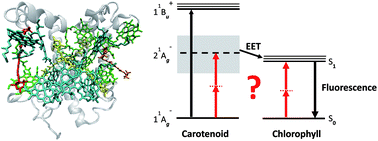
Faraday Discuss., 2019,216, 494-506
https://doi.org/10.1039/C8FD00198G
Decomposing electronic and lattice contributions in optical pump – X-ray probe transient inner-shell absorption spectroscopy of CuO
Laser-induced energy deposition and heat transport in CuO is studied by picosecond time-resolved X-ray absorption spectroscopy.

Faraday Discuss., 2019,216, 414-433
https://doi.org/10.1039/C8FD00236C
Coupled excitation energy and charge transfer dynamics in reaction centre inspired model systems
We present numerical simulations on bacterial reaction centre (bRC) inspired model systems that utilize the recently developed MACGIC-iQUAPI method.
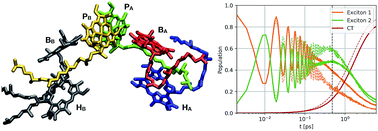
Faraday Discuss., 2019,216, 72-93
https://doi.org/10.1039/C8FD00189H
Symmetry breaking charge transfer as a means to study electron transfer with no driving force
Herein we explore the symmetry breaking charge transfer process in two dipyrrin-based bichromophoric systems.
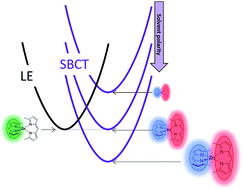
Faraday Discuss., 2019,216, 379-394
https://doi.org/10.1039/C8FD00201K
Probing eumelanin photoprotection using a catechol:quinone heterodimer model system
Here, we investigate the photochemistry of a catechol : o-quinone heterodimer as a model system for uncovering the photoprotective roots of eumelanin.
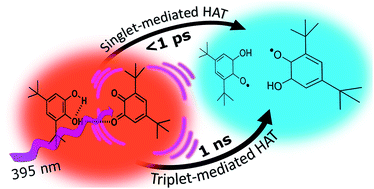
Faraday Discuss., 2019,216, 520-537
https://doi.org/10.1039/C8FD00231B
Quantum coherence in ultrafast photo-driven charge separation
Ultrafast electron transfer occurs with greater-than-statistical rate enhancement at cryogenic temperatures owing to quantum coherence.
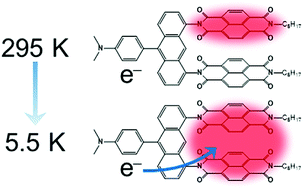
Faraday Discuss., 2019,216, 319-338
https://doi.org/10.1039/C8FD00218E
Theoretical analysis of the inverted region in photoinduced proton-coupled electron transfer
Photoinduced proton-coupled electron transfer (PCET) plays a key role in a wide range of energy conversion processes, and understanding how to design systems to control the PCET rate constant is a significant challenge.
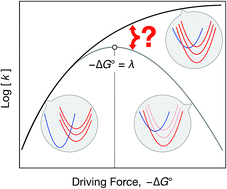
Faraday Discuss., 2019,216, 363-378
https://doi.org/10.1039/C8FD00240A
Systematic control of the rate of singlet fission within 6,13-diphenylpentacene aggregates with PbS quantum dot templates
Perturbation of molecular packing and dielectric environment at a quantum dot surface can promote singlet fission in diphenylpentacene aggregates.
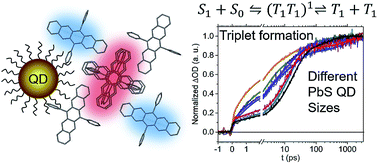
Faraday Discuss., 2019,216, 162-173
https://doi.org/10.1039/C8FD00157J
Ultrafast transient absorption spectroscopy of doped P3HT films: distinguishing free and trapped polarons
It is generally presumed that the vast majority of carriers created by chemical doping of semiconducting polymer films are coulombically trapped by the counteranion, with only a small fraction that are free and responsible for the increased conductivity essential for organic electronic applications.
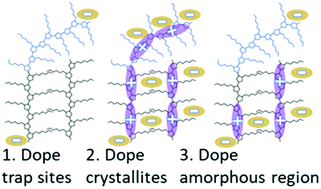
Faraday Discuss., 2019,216, 339-362
https://doi.org/10.1039/C8FD00210J
Understanding the potential for efficient triplet harvesting with hot excitons
Excited state energy transfer in disordered systems has attracted significant attention owing to the importance of this phenomenon in both artificial and natural systems that operate in electronically excited states.
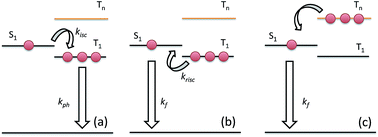
Faraday Discuss., 2019,216, 395-413
https://doi.org/10.1039/C8FD00174J
Light harvesting and energy transfer in a porphyrin-based metal organic framework
We present the synthesis and photophysical characterization of a water stable PCN-223(freebase) metal organic framework (MOF) constructed from meso-tetrakis(4-carboxyphenyl)porphyrin (TCPP).
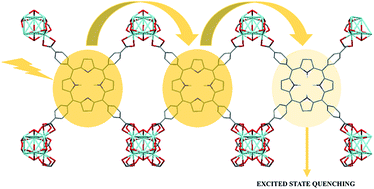
Faraday Discuss., 2019,216, 174-190
https://doi.org/10.1039/C8FD00194D
Donor–acceptor preassociation, excited state solvation threshold, and optical energy cost as challenges in chemical applications of photobases
Photobases convert light energy to proton removal power. What limits their applicability? Hydrogen bonding, solvation, and photon energy cost.
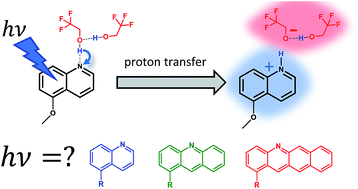
Faraday Discuss., 2019,216, 252-268
https://doi.org/10.1039/C8FD00215K
Role of charge transfer states into the formation of cyclobutane pyrimidine dimers in DNA
Sequence affects the energetics and role of charge transfer in oligonucleotides.
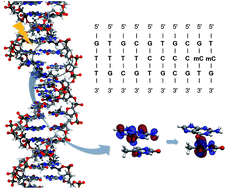
Faraday Discuss., 2019,216, 507-519
https://doi.org/10.1039/C8FD00184G
Carotenoid–chlorophyll energy transfer in the fucoxanthin–chlorophyll complex binding a fucoxanthin acyloxy derivative
A fucoxanthin derivative has negligible charge-transfer character of the S1/ICT state resulting in slowing down of the carotenoid–chlorophyll energy transfer.
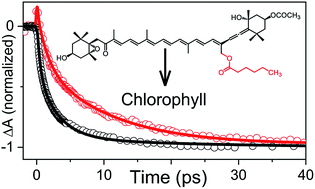
Faraday Discuss., 2019,216, 460-475
https://doi.org/10.1039/C8FD00193F
Photo-protection/photo-damage in natural systems: general discussion
Faraday Discuss., 2019,216, 538-563
https://doi.org/10.1039/C9FD90031D
Photovoltaics and bio-inspired light harvesting: general discussion
Faraday Discuss., 2019,216, 269-300
https://doi.org/10.1039/C9FD90028D
Energy and charge-transfer in natural photosynthesis: general discussion
Faraday Discuss., 2019,216, 133-161
https://doi.org/10.1039/C9FD90027F
Photo-induced electron transfer: general discussion
Faraday Discuss., 2019,216, 434-459
https://doi.org/10.1039/C9FD90029B
About this collection
We are delighted to share with you a selection of the papers which will be presented at our Faraday Discussion on Ultrafast photoinduced energy and charge transfer taking place in Ventura, California, USA in April 2019. More information about the event may be found here: http://rsc.li/ultrafast-fd2019. Additional articles will be added to the collection as they are published. The final versions of all the articles presented and a record of the live discussions will be published after the event.
Ultrafast energy and charge transfer events dictate the functionality of a broad range of molecular, aggregate and nanomaterial systems. Impressive recent advances in the commercialisation of ultrafast laser technology and on many theoretical fronts, plus the societal emphasis on solar energy have led to a surge of research in this community, encompassing spectroscopists, biophysicists, computational and theoretical chemists, physicists and materials scientists. Ambitions have evolved beyond studies of simple molecular systems, and increasingly focus on the underlying molecular mechanisms prevailing in nanomaterial, native protein and hybrid systems. Many working in this area share a common aim, to address and answer one of the most pressing issues currently facing the scientific community: the photophysics underlying efficient light capture, energy transport and efficient charge carrier generation, water splitting, photoprotection and photodamage, proton transfer and/or molecular re-organisation.
This Faraday Discussion aims to bring together leading experimental and theoretical colleagues who use an ever-increasing range of spectroscopic probes and computational methods to explore photo-induced biomolecular and nanoscale dynamics. Topics for discussion will span, but not be limited to, the mechanisms of energy transfer in both natural and synthetic systems, including the role of electronic/vibronic coherences, key design features required for efficient proton coupled electron transfer, and molecular mechanisms of natural photo-protection.